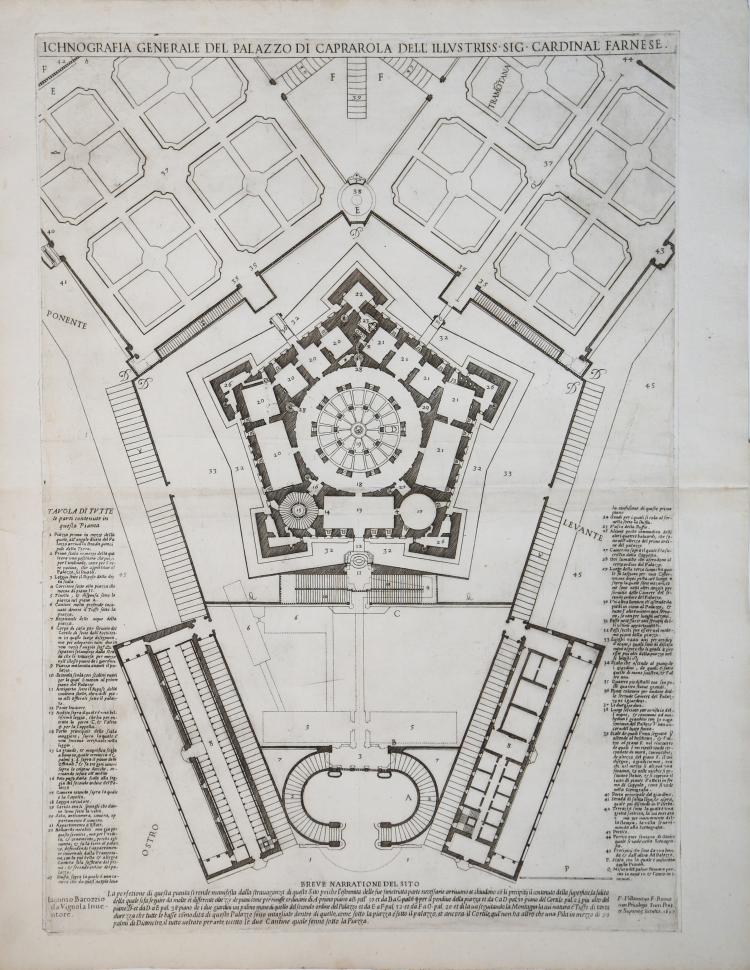



| Reference: | S41539.2 |
| Author | Francesco VILLAMENA |
| Year: | 1617 |
| Printed: | Rome |
| Measures: | 365 x 508 mm |


| Reference: | S41539.2 |
| Author | Francesco VILLAMENA |
| Year: | 1617 |
| Printed: | Rome |
| Measures: | 365 x 508 mm |
Engraving, 1617; printed on contemporary laid watermarked paper, in very good condition.
At top: ICHNOGRAFIA GENERALE DEL PALAZZO DI CAPRAROLA DELL’ILLUSTRISS SIG CARDINAL FARNESE
From the series: “Alcune opera d’archiettetura di Jacomo Barotio da Vignola Raccolte e poste in luce da Francesco Villamena l’anno MDCXVII”.
The palace was one of the many stately mansions built by the Farnese in their domains. Initially it had to have defensive characteristics as it was common in the noble residences of the Latium territory between the fifteenth and sixteenth centuries. The construction of a fortified residence in Caprarola was initially entrusted by Cardinal Alessandro Farnese il Vecchio to Antonio da Sangallo the Younger who designed a pentagonal fortress with angular bastions. The works began in 1530, but were suspended in 1546 due to the death of Sangallo. Cardinal Alessandro the Younger, who set up in his turn in Caprarola, wanted to resume his grandfather's project, so, in 1547, he entrusted the construction to Vignola, but the works resumed only in 1559. Vignola, whose defensive purpose failed, radically changed the original project: the building, while maintaining the pentagonal plan of the original fortification, was transformed into an imposing Renaissance palace, which later became the summer residence of the cardinal and his court. In place of the corner ramparts, the architect inserted large open terraces onto the surrounding countryside, while at the center of the residence was a circular two-storey courtyard, with the upper slightly set back. Vignola cut the hill with stairways in order to isolate the building and, at the same time, integrate it harmoniously with the surrounding territory; furthermore, a straight road was opened in the center of the village below, so as to visually connect the building to the town and enhance its dominant position over the entire town. Vignola personally directed the work at least until 1564 and in any case in his death, in 1573, the building was practically completed.
Francesco VILLAMENA (Assisi, 1564 - Roma, 7 Luglio 1624)
|
Italian engraver. According to tradition, he was a pupil of Cornelis Cort, whose engravings he copied, and was associated in his youth with Agostino Carracci. He made few original engravings but reproduced designs of artists including Raphael, Paolo Veronese, Federico Barocci, Girolamo Muziano and Giulio Romano. His output also included frontispieces and book illustrations. Closely related to such northern late adherents of Mannerism as Hendrick Goltzius and Jacques Bellange, he employed an elegant and expressive calligraphic style with perfect control of the burin. In addition to religious and historical subjects, he executed portraits, notably a series of genre figures (Rome, Gab. N. Stampe). In 1594 he executed a series of engravings illustrating scenes from the Life of St Francis. His oeuvre comprised at least one hundred plates.
|
Francesco VILLAMENA (Assisi, 1564 - Roma, 7 Luglio 1624)
|
Italian engraver. According to tradition, he was a pupil of Cornelis Cort, whose engravings he copied, and was associated in his youth with Agostino Carracci. He made few original engravings but reproduced designs of artists including Raphael, Paolo Veronese, Federico Barocci, Girolamo Muziano and Giulio Romano. His output also included frontispieces and book illustrations. Closely related to such northern late adherents of Mannerism as Hendrick Goltzius and Jacques Bellange, he employed an elegant and expressive calligraphic style with perfect control of the burin. In addition to religious and historical subjects, he executed portraits, notably a series of genre figures (Rome, Gab. N. Stampe). In 1594 he executed a series of engravings illustrating scenes from the Life of St Francis. His oeuvre comprised at least one hundred plates.
|